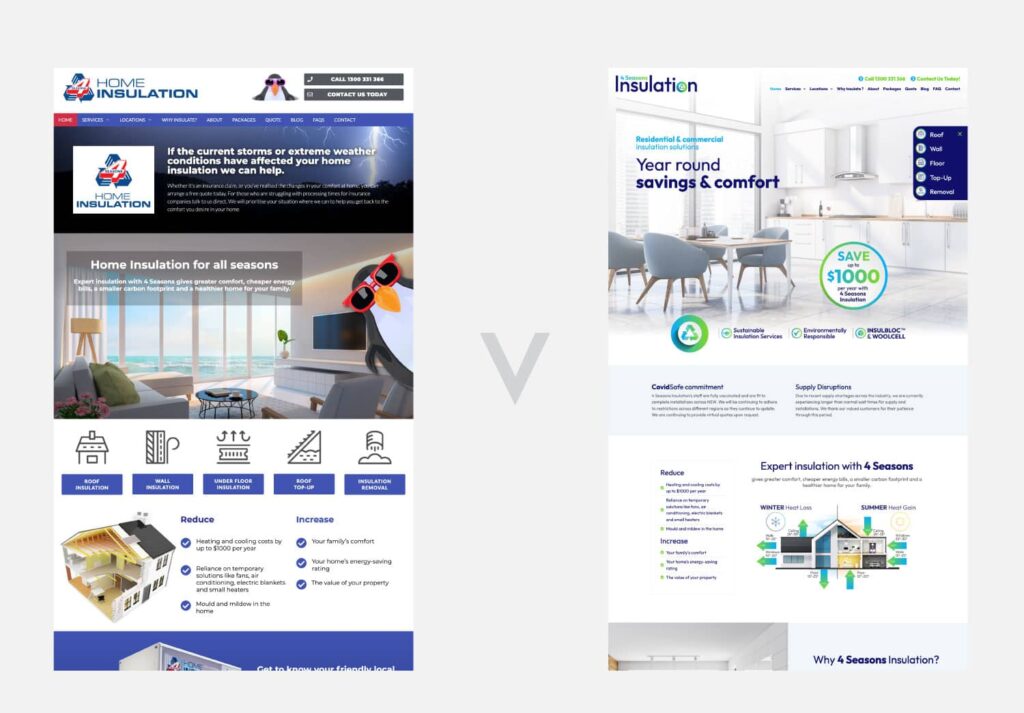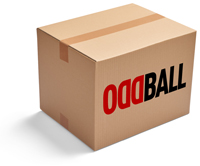Congratulations on the launch of your new website! Time to pack it in and call it a day, right?
Here’s some food for thought – has your website been optimised for search engines?
Whether you’ve launched a completely new website, or given your old site a refresh, SEO is a vital aspect to ensuring your site can rank.
If it hasn’t been optimised, a new website will struggle to acquire new users organically, and a redesigned website can lose rankings, ruining all your hard work.
Oddball knows firsthand the power of redesigning new websites. Designing a new website to modernise your brand can have massive benefits.

Five months after a redesign, one of our clients saw a 98% increase in their conversion rate, rising from 4% to 8%.

Another of our clients now has 40% more users in the eight months after re-doing their site.
But how can we help you achieve results like these for your site? Keep reading…
A Beginners Intro To SEO
SEO stands for Search Engine Optimisation. It involves improving certain aspects of your website and the pages on it to ensure when people search for the service you provide, you have a chance to appear.
If you’re an insulation business, you want to make sure anytime someone searches “Insulation Central Coast” (or whatever location you are), your business is on page one, preferably in the top three results.
To achieve this, you need to optimise your site for search engines.
Basic SEO Fundamentals
Keywords
Possibly the most important first step for SEO is finding out which keywords you want to tailor your site around.
There are many ways to skin a cat, and this also applies to SEO keywords.
A keyword is the main descriptor for that page. For your home page, it will likely be a bit more broader of a term, like “Insulation Central Coast”.
For internal pages throughout, like a roof insulation page, it will be something like “Roof Insulation Central Coast”.
Whatever purpose the specific page has, find a keyword for it, and optimise the page to revolve around it.
So, how do you make an educated guess at what your best keyword is?
You need to grab some tools from your SEO belt, and get to work.
The most accurate keyword research tool is Google Ads keyword planner. There’s no better place to get insight into search volume for Google.
There are other free or paid options available like SEMrush and Ahrefs, but Google’s keyword planner is more than enough for you to start out.
Once you’ve completed your keyword research, you’re nearly ready to start implementing them throughout the site. However, first we need to discuss SERP and user intent.
SERP (Search Engine Result Page) & User Intent
To explain this we’re going to run a quick test. Play along at home, or continue reading to see how search intent is used.
Search “how to remove pimples”.
What do you notice about what you see? Sure, they’re all search results that relate to getting rid of pimples, but look a little harder. What do you actually see?

We didn’t specify that we wanted to remove pimples fast, but Google knows it’s probably what’s implied, so it’s shown.
This is an extreme example, but it highlights a really important aspect of SEO – make sure you match your content to what you want to rank for.
How?
A common method is using location qualifiers.
By including the location in your title and header tags, you’re telling Google that your content is relevant for individuals who need that product or service in that area.
Let’s take a fencing business as an example.
If you just searched “fencing”, you’re going to get a lot of vague searches, because Google has no idea of your intent.
Are you researching different types? Trying to understand the difference between materials? Looking for suppliers or installers? How about two people dressed in all-white poking each other with a stick?
But if you change your search to “fencing Central Coast”, you’ll get much more focused results.
So make it easy for Google to rank your website, and take into consideration the SERP intent behind user search.
SEO Ranking Factors
Google is very complicated. Their algorithm uses dozens of ranking factors to figure out what sites should rank depending on what an individual searches for.
To understand what your site is all about, they use something called a ‘crawler’ or ‘spider’, which goes through your site and figures out what you’re showcasing, who it would be relevant for, and if the content is reputable.
They also consider other factors like backlinks (links to your site from other websites), conversions (Google assumes a site with high conversions is trustworthy), and site speed (how quickly the page loads).
This is a very quick explanation of what goes into determining your rank.
All you need to keep in mind is that humans aren’t the only ones that’ll be visiting your site, so your content needs to cater to your customers and these search crawlers.
Keywords are a big factor in optimising your content for crawlers. But what else do you need to care about, and how do you implement best practice? Let’s break it down.
Important SEO Aspects To Work On
Titles and Meta
Arguably your most important first step is sorting out your titles and meta descriptions. This is what people see on Google after searching for something.
They’re a double whammy – they tell Google exactly what this page is about, helping you rank, and they tell users what to expect if they click.
Meta descriptions on the other hand don’t play an active role in helping you rank, they’re purely for users to read.
But just because Google doesn’t care what’s in them doesn’t mean you can afford to neglect them.
Metas are very important in articulating what your page is going to address for the searcher. A good meta will drive home the point and entice people to click on your site, which increases your Click-Through-Rate (CTR).
Whilst metas aren’t a ranking factor, CTR is, so you need to ensure your meta descriptions are rock solid.
The character limit for titles is 60 – anything over and you’ll see “…”. For metas, you have about 160 before you hit the dreaded three dots.
Header Tags
Next up on your hitlist is headers.
These are really handy because they serve as a great way to break up a page, making it easier to read.
Google crawlers also place a lot of value in these, so it’s a great opportunity to use a keyword in them.
Some best practice tips:
- Only have one H1
- Utilise H2s for identifying new sections
- Use H3s and H4s for important parts within a wider section.
As an easy representation of what we’re describing, take this blog for example.
Our H1 is the title “An SEO Guide For Your New Website”. Within this section, the H2 is “Important SEO Aspects To Work On”, and our H3 is “Headers”.
Some things to be aware of:
- Multiple H1s can confuse search engine crawlers. Avoid them unless you know what you’re doing
- Don’t over-stuff keywords in your headers – find ways to naturally include them
- Anything past H5 doesn’t achieve much
Image optimisation
A great opportunity for optimisation is images. This is where keywords are again used in a big way.
Image title and alt-text are big-ticket items to improve, utilising relevant keywords wherever appropriate.
Another aspect of image optimisation is file size. Smaller image sizes will help your page load time and ensure people aren’t bouncing from your page because of a slow-loading image.
Our final image optimisation tip is geotagging. By adding geographical positioning data to images, you help search crawlers understand how location is relevant to the page or article.
Internal Links
Something often overlooked is the user journey. For every page on your site, ask yourself how someone will actually get to this page.
The more links you have interconnecting your site, the easier it is to navigate for your users.
Easy wins are adding pages to your menu structure, and linking off from the home page.
But there’s more you can do.
Go through every page on your website, and find opportunities to internally link via anchor text
There’s more to this than just the user journey though. We also need to consider link juice.
When an external website links to your site, that’s called a backlink. We’re not going to address the complexities of that in this basic SEO guide, but it’s something to be aware of.
If this backlinking site is a big-hitter, like a news, government, or major business website, their site sends valuable link juice to your site.
It’s basically a search crawler equivalent of a word-of-mouth recommendation.
Here’s the thing though, this applies internally as well.
If you have a page that is only linked once or twice within your whole site, crawlers are going to assume that the page is irrelevant and worthless.
So you need to be linking these pages as much as possible, so crawlers can find multiple ways to get to that page.
Your home page is the biggest link juice distributor. Other great pages to link from are high traffic blogs.
That’s why when you publish a new blog, you should go through your old articles and add links where appropriate to your new content.
Content
Creating content for your site in the form of blogs is a major influence on ranking. It shows crawlers that you’re active on your site publishing articles for current and future users.
It also provides you with another opportunity to reach people who may be at a different stage in the buying journey.
For an ecommerce site selling barware, without blog content the site can only hope to acquire users who wish to purchase items for their bar.
There’s a major opportunity for all the people who are not yet ready to purchase, and are instead gathering information.
By having content on your site that attracts people at a different stage of the buying journey, your business is no longer just a service or product provider, but also a facilitator of knowledge.
You get to dictate the information they absorb, and at the end you can provide a call to action, showing them you provide something they may be interested in.
If you’re looking for more information, we have an article discussing how to optimise your blog that might be helpful (there’s that anchor text we mentioned earlier).
Tracking Your SEO Success
You’ve now got a basic understanding of how to optimise your site. We’re done now, right?
Not exactly.
SEO is what we in the business call a “long-term game”. If we could implement our changes and have your site rank No.1 after one month of work, SEO would be a one-and-done job.
But it’s not.
Any SEO expert knows monitoring is a major part of the job. Monitoring performance and making changes to the strategy is a routine task.
This basic SEO guide will help you get to page one, but to rise the ranks and be in position No.1 will require frequent check ups and refinement.
To do this, you’ll need to take advantage of a few different data processing systems. The two you absolutely must have are both free, so there’s no excuse.
Number one is Google Analytics. It gives you a complete overview of how many people have visited your site, what actions they’re taking, and even provides insight into where you need to focus your attention.
Next is Google Search Console. This will give you insight into how many impressions you’re getting on Google, again providing ideas for areas you can improve.
With Analytics and Search Console you’ll be able to track performance and make refinements as you go over time.
It’s important to stress that it can take three to six months before seeing major improvement, so don’t panic if after a week your changes haven’t resulted in increased activity.
Finishing Up Our Basic SEO Guide
This guide was created for people who have just launched their website and have a limited understanding of SEO.
In the effort to not overwhelm you, a lot has been left out.
That’s not to say there isn’t enough in this to make a genuine impact, but you should be aware that SEO can be a challenging battle.
We’ve given you enough keys to unlock most of the journey. There’s still a lot you’ll have to learn about down the road to ensure your site continues to improve.
Backlinks, schema, new service/ product pages, off-page SEO, website speed, UI and UE, and mobile optimisation are all things you’ll have to start considering once you’ve nailed the basics.
We’re committed to helping people optimise their site, which is why we’re happy to lend a hand and provide you with a free website audit.
Fill in your details below and we’ll conduct an SEO audit on your website, and email you the details.
Bringing In The Big Guns
If you’ve decided you don’t have the time to handle SEO for your website, you’ll need to consider talking to an SEO expert.
On the other hand, if you’re happy with how far your work has come, but have now hit a wall and need assistance handling the more advanced aspects, give us a call today to discuss your needs and what Oddball can do for you.






